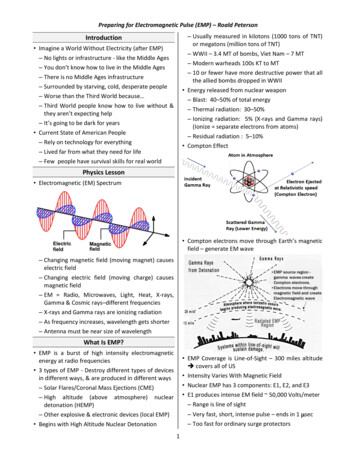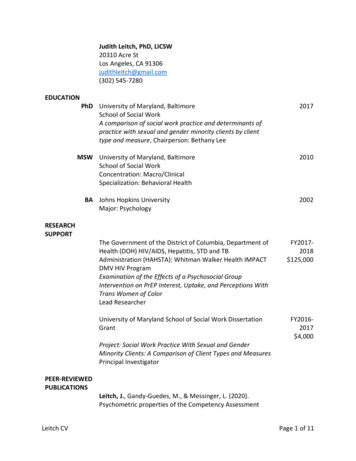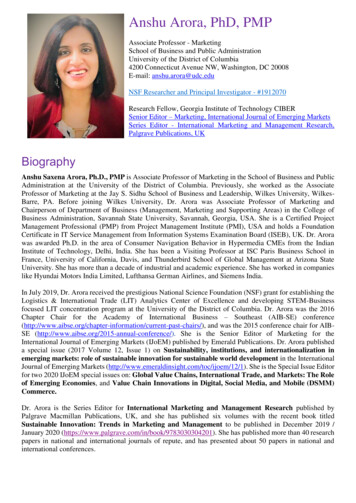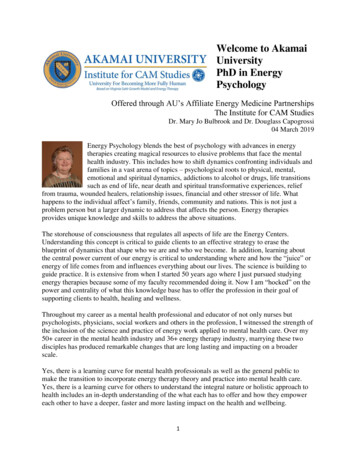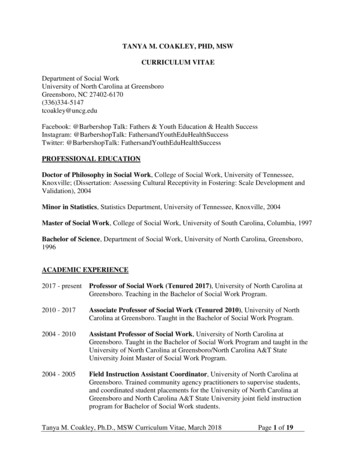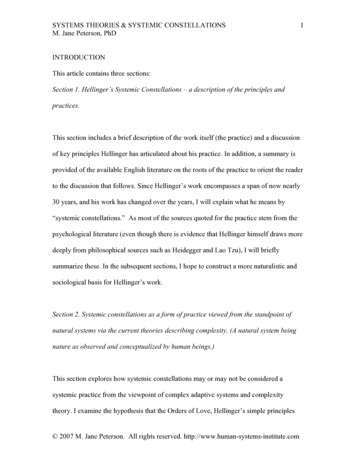
Transcription
SYSTEMS THEORIES & SYSTEMIC CONSTELLATIONSM. Jane Peterson, PhD1INTRODUCTIONThis article contains three sections:Section 1. Hellinger’s Systemic Constellations – a description of the principles andpractices.This section includes a brief description of the work itself (the practice) and a discussionof key principles Hellinger has articulated about his practice. In addition, a summary isprovided of the available English literature on the roots of the practice to orient the readerto the discussion that follows. Since Hellinger’s work encompasses a span of now nearly30 years, and his work has changed over the years, I will explain what he means by“systemic constellations.” As most of the sources quoted for the practice stem from thepsychological literature (even though there is evidence that Hellinger himself draws moredeeply from philosophical sources such as Heidegger and Lao Tzu), I will brieflysummarize these. In the subsequent sections, I hope to construct a more naturalistic andsociological basis for Hellinger’s work.Section 2. Systemic constellations as a form of practice viewed from the standpoint ofnatural systems via the current theories describing complexity. (A natural system beingnature as observed and conceptualized by human beings.)This section explores how systemic constellations may or may not be considered asystemic practice from the viewpoint of complex adaptive systems and complexitytheory. I examine the hypothesis that the Orders of Love, Hellinger’s simple principles 2007 M. Jane Peterson. All rights reserved. http://www.human-systems-institute.com
SYSTEMS THEORIES & SYSTEMIC CONSTELLATIONSM. Jane Peterson, PhD2regarding the behavior of family systems and the action of conscience in a family, couldbe explained as simple rules that create the complex behavior observed in the many formsof constellations encountered in the practice. Structural coupling is explored as ametaphor for understanding how family traumas are passed down from one generation tothe next. The “knowing field” is briefly discussed as an emergent property of humansocial interaction.Section 3. Social Constructionism is explored as a viewpoint from which to evaluate thepractice of systemic constellations.This section explores basic assertions of social constructionism and compares them toHellinger’s writings and practices. The dialectic between modernism and socialconstruction is also explored. Hellinger’s work is brought in as a third voice in thisconversation. The final portion of this section contains my conclusions and reflections asa result of writing this article.SECTION 1: HELLINGER’S SYSTEMIC CONSTELLATION WORKThe Wind of FateIn a group, a man told how, as a boy, he had sat on a high hill and watched hisvillage being attacked and destroyed by neighbors who belonged to anotherreligion. He described his hatred toward those men, some of whom he had knownand liked. He told how a thought had come unbidden as he watched: What wouldI feel if I had been born into one of those families? What if a wind had blown mysoul a few hundred meters off course, and I had entered the belly of one of thosemothers, instead of my own mother? Then I would feel victory and pride, as theydo, and not grief and rage, as I do—and I would hate us and love them.--Hellinger (1998) 2007 M. Jane Peterson. All rights reserved. http://www.human-systems-institute.com
SYSTEMS THEORIES & SYSTEMIC CONSTELLATIONSM. Jane Peterson, PhD3How Can We Know Peace?In a television documentary, a young man was filmed beside a cave. Manythousands of bodies had been found in the cave, lying in three layers. The bodiesin the first layer were those of adherents to a particular political persuasion whohad been murdered by adherents to another group in retribution for injusticesdone. The bodies in the second layer were those of members of the second partymurdered in retribution some years later by members of the first. The tide ofpower in that country had shifted again, and the third layers again containedbodies of members of the first party murdered, in retribution, by their enemies.The young man, whose relatives were among the bodies in the middle layer killedalmost 50 years previously, was asked if there would be an end to the killing. Hereplied, “When we hear the cries of our mothers, and see their tears for theirmurdered sons, how can we know peace? We must avenge their loss.--Hellinger (1998)“The man in this documentary believed he was acting freely, but he was not. Because heloved blindly, he was caught in a web of tragedy that had begun long before he was born,demanded his obedience, and, tragically, will not end until long after his death.”Hellinger (1998)Bert Hellinger is a controversial and colorful psychoanalyst now entering his eighties. Inthe early 1980’s while working with family systems in a group therapy setting, hestumbled across a phenomenon that has come to be known variously as family ororganizational constellations or, a more encompassing term, systemic constellation work(SCW) Later developments have been called “movement of the soul” and “movement ofthe spirit mind.” This work represents a lifetime of exploration by a creative thinker andexplorer in the field of family systems dynamics. In the last ten years Hellinger’ssystemic constellation work has spread rapidly and is now practiced in over 33 countriesworldwide.1 Also during this time, this way of working has been successfully expandedto organizational consulting, education, corporate branding, prison work, and health and 2007 M. Jane Peterson. All rights reserved. http://www.human-systems-institute.com
SYSTEMS THEORIES & SYSTEMIC CONSTELLATIONSM. Jane Peterson, PhD4medical issues, including chronic illness and addiction, to name a few of the main fieldsthat are experimenting with systemic constellation work.As a practitioner of this work myself for the past eight years, I have worked in Europe,Hong Kong, China, Taiwan, Malaysia, Canada, Mexico and the United States. As is truefor all facilitators I have spoken with, I have found that the constellation work seems tohave a universal appeal. I am indebted to Bert Hellinger for the practical wisdom andchallenging honesty he has brought to his pursuit of understanding the complex dynamicsof family systems. It would not be amiss to say that this work has significantly changedmy life for the better and also given me an unexpected and personally enrichinglivelihood (a “learning-hood” as I like to call it.) Since I am deeply involved in thispractice, I cannot be considered to be a neutral observer of this work and cannot help butbring my own experiences and biases into the perspective I take in exploringconstellation work through the lenses of complexity theory and social constructionism. Iask the reader to keep that in mind while reading this article.As the reader knows, there are a variety of ways that this work is done. The mosttraditional is: 1) Facilitator evokes and clarifies the client’s issue; 2) Representatives forthe significant members of the client’s system are chosen and placed by the client; 3)Representatives report on their experience; 4) Facilitator experiments with differentpositions and movements of the representatives; 5) When possible, a final resolution isachieved. 2007 M. Jane Peterson. All rights reserved. http://www.human-systems-institute.com
SYSTEMS THEORIES & SYSTEMIC CONSTELLATIONSM. Jane Peterson, PhD5As a practitioner and a trainer of this work I see four important claims made by Hellingerthat are germane to this paper.1. Trans-generational patterns exist in family systems.2. It is possible to represent members of the system with other people who do not knowthe client or the people in the system.3. Common kinds of orders patterns or “hidden symmetries” emerge in intimate relationsbetween people.4. The body knows what the mind does not about our relationships.1. Trans-generational Patterns in Family Systems.The young ones are the future of the old ones. Somé (1993)First is the claim that events that happen in an earlier generation may affect members ofthe system in later generations even though these later descendants may not be directlyaware of the entanglement. This is, of course, not a new claim. Working in theconstellation format, Hellinger, like many family therapists and theorists before him,builds upon models of the trans-generational nature of disturbances in family systems.What is unresolved in one generation seems to be picked up by the next and continued inoften hard to understand ways. Clarifying the nature of these trans-generational patternsis one of the chief contributions that Hellinger’s work has made to the field of familytherapy. Virginia Satir and others such as Ivan Boszormenyi-Nagi, Murray Bowen, andEric Berne have certainly pointed to this phenomenon. More similarities can be foundwith geno-sociogram therapists such as Anne Ancelin Schutzenberger. Hellinger, 2007 M. Jane Peterson. All rights reserved. http://www.human-systems-institute.com
SYSTEMS THEORIES & SYSTEMIC CONSTELLATIONSM. Jane Peterson, PhD6however, extended this trans-generational work much more thoroughly, includingexploring the larger historical and cultural contexts that impact the fate of individuals andfamily systems, as the quotes opening this section indicate.Besides the surprising synchronicities and accuracy of events that are representedspontaneously in the constellations themselves, Hellinger supports his claims of transgenerational patterns through the concept (also formulated by others) of identification ofa family member of one generation with a member of a previous generation, typically amember who has been excluded by the family.“Identification is like a systemic repetition compulsion. It attempts to recreate andreproduce the past in order to bring justice to an excluded person. But such justiceis primitive and blind, and it brings no resolution. In this dynamic, later personsbecome entangled in the destiny of an earlier person. Even if their actions aremotivated by love, they take upon themselves an inappropriate responsibility. Alater person can’t set something in order for an earlier person after the fact. Such aretroactive justice only continues the systemic imbalance indefinitely.”(Hellinger, 1998)An example of these trans-generational entanglements is the “double shift” where the fateof the original protagonist is picked up by a different “subject” in a subsequentgeneration, and the “object” of the original event is then projected onto someone else inthe family. I will share a case from my own work to illustrate this trans-generationalphenomenon. 2007 M. Jane Peterson. All rights reserved. http://www.human-systems-institute.com
SYSTEMS THEORIES & SYSTEMIC CONSTELLATIONSM. Jane Peterson, PhDExample of a “double shift” trans-generational identificationA woman had been angry with her husband for no reason that she could ascertain sinceearly in their marriage. 1 The couple had a nine-year-old daughter. The husband, by allaccounts of those who knew him well, was a very decent man and put up withconsiderable verbal abuse from his wife. Neither of them could really understand heranger at him, although over the years the wife had justified it with various stories. Inaddition the wife had a physical symptom that she was concerned about that was relatedto her respiratory system and inner organs, and experienced as a consistent chest pain.Because the wife was the most concerned about the issue, I asked her to place therepresentatives in the constellation.As soon as the wife had placed representatives in the constellation for herself, herhusband and their child, the wife’s representative started coughing and had an intensefeeling of being strangled or choked. She also reported chest pains and difficultybreathing. The son’s representative felt very shaky and wanted to look away from hismother. He felt better when I moved him closer to the father’s representative. Thefather’s representative was perplexed by his wife’s behavior, but felt quite solid.When I asked the wife who in her family or origin had been strangled or had beenchoked, at first she could not think of any one. The husband and wife discussed herfamily system for a few minutes. Finally, the wife remembered that her aunt hadcommitted suicide by self-strangulation. The mention of the aunt relieved the wife’s1Details in all cases presented from my own work have been changed in order to keepconfidential the identity of the clients. 2007 M. Jane Peterson. All rights reserved. http://www.human-systems-institute.com7
SYSTEMS THEORIES & SYSTEMIC CONSTELLATIONSM. Jane Peterson, PhD8representative a little. Although the aunt had had a husband and small children, she hadbecome involved with another man and wanted to leave her husband for the lover. Thelover spurned the aunt and in shame and anger she had hung herself.The wife added representatives to the constellation for her mother and the aunt. As soonas these representatives were placed, the wife’s representative began to relax. She did notlook at the representative of her mother; instead, the wife’s representative’s focus went tothe representative for the aunt. The representative for the aunt was very uncomfortable,both physically and emotionally, and also had felt tightness in the throat. The wife’smother’s representative was horrified, grief-stricken and also deeply ashamed of heryounger sister’s act and found it very difficult to look at her. Instead, her daughter’srepresentative (the wife’s representative) looked at the aunt. The wife reported that theshame in the family was so great that this trauma was very seldom discussed and the auntrarely mentioned.The wife suddenly realized she had assumed the aunt’s violent but ineffectual ragetowards her lover, but instead directed it to her husband. As it turns out her husband wasborn and grew up in the same village where the lover was from. The wife said she alway
Bert Hellinger is a controversial and colorful psychoanalyst now entering his eighties. In the early 1980’s while working with family systems in a group therapy setting, he stumbled across a phenomenon that has come to be known variously as family or organizational constellations or, a more encompassing term, systemic constellation work (SCW) Later developments have been called “movement .

